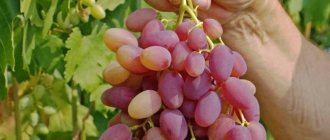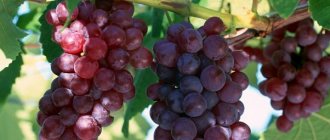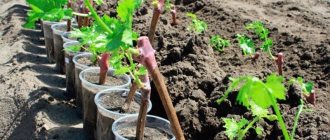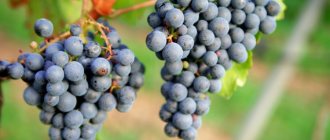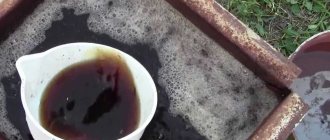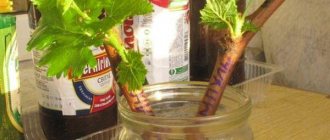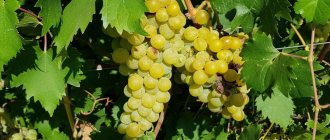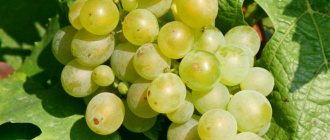Without exaggeration, the Nizina table grape variety can be called a pioneer of modern domestic folk selection. Its appearance at the end of the last millennium became a kind of guiding star for a whole galaxy of folk breeders, inspired by the successful experience of amateur crossing of grapes and the amazing results obtained. The author of the new product was Viktor Krainov, a legendary figure among winegrowers, who then created several dozen more wonderful hybrid forms, many of which officially became varieties.
Viktor Nikolaevich subsequently described the history of the appearance of Lowland in detail in an interview. According to him, he began to engage in viticulture in 1953 at the age of fifteen on his father’s plot. In 1986, he purchased land on the banks of the Tuzla River in the Rostov region, where he planted his own vineyard, not yet even dreaming of breeding work. He was pushed to this direction of activity by the famous scientist, leading breeder of the Novocherkassk Research Institute of Viticulture and Winemaking Ivan Kostrikin. He suggested that Viktor Krainov and several other winegrowers conduct simple experiments on crossing grapes on their plots, and to make the task easier, he recommended using varieties with a functionally female type of flowering as the mother form, which excluded the possibility of their self-pollination. The most promising candidate in this regard was the brainchild of Kostrikin himself - a large-fruited and rather unpretentious, at that time still a hybrid, Talisman.
The beginning “Michurinets” Krainov chose three parent pairs for his first experiments in 1995-1996: Talisman x Kishmish radiant, Talisman x Autumn Black and Talisman x Tomaisky. All three paternal varieties were originally from Moldova, where at different times they were obtained by specialists from the local research institute of viticulture and winemaking “Vierul”. The choice turned out to be surprisingly successful; just crossing Talisman with Kishmish radiata made it possible to later select several grape seedlings with clusters of excellent appearance and taste. However, the offspring of another couple, Talisman and Tomaisky, were the first to bear fruit in 1998, and it was among them that Viktor Nikolaevich singled out the wonderful Nizina.
The new large-fruited, very tasty and relatively unpretentious hybrid to grow gradually gained very wide popularity among amateur winegrowers, and in 2015 it successfully completed state variety testing and was officially recommended for cultivation in garden plots throughout the country.
Advantages and disadvantages
Advantages:
- Huge brushes and berries.
- Fast growth.
- Good yield indicators.
- Possibility of long-term storage of fruits.
- Frost resistance and good resistance to many diseases.
Flaws:
- The need for crop rationing.
- Tendency to be affected by oidium.
- Not used in winemaking.
- The need for a large area for bush growth.
- The need for systematic feeding for good fruiting.
Advantages of the variety
The “Nizina” grape variety has the following characteristics and stated advantages:
- possibility of getting an early harvest;
- high yields with very stable annual indicators;
- high taste quality and presentation of ripe grape bunches;
- good transportability of the crop;
- frost resistance of the hybrid form up to - 23° C;
- resistance to mildew at 3 points;
- sufficient resistance to gray rot.
In addition, no damage to the berries by wasps or hornets was observed during cultivation. Sufficient stability allows the cultivation of this hybrid form in the climatic conditions of the central zone of our country.
Origin
The crossing of “talisman” (“kesha 1”) and “tomai”, carried out by amateur breeder V. Krainov, gave the world a new hybrid grape variety - “lowland”. This successful experiment was carried out in 1998, and since then this grape has been a constant winner in the ratings of the most successful breeding creations.
Parents of the “lowland” – “talisman” and “tomai”
Reference! The correct name of the variety is written unusually, with two capital letters - “NiZina”. Everything is explained simply: the name of the hybrid is a merger of the names of the wives (Nina and Zina) of famous breeders - Krainov and Kostyrkin.
Main characteristics
“Nizina” is a table grape variety. It is best to eat it fresh. Huge brushes with large berries will be a real decoration for any table, including a holiday one. You can also use them to prepare desserts or salads. But you won’t be able to get high-quality wine: the proportions of sugar and acidity are wrong. It is also worth mentioning such Krainova varieties as “transfiguration”, “Antony the Great” and “Victor”.
Ripening period
“Nizina” is a mid-season variety, since its full vegetation cycle takes 125–130 days. Harvest time largely depends on weather conditions and latitude of the region. As a rule, in the southern regions the harvest can begin in mid-August, in the central regions - at the end of the last month of summer, and in northern latitudes - in the first ten days of September.
Bush
The bush of this variety is considered vigorous. The length of the vines ranges from 15 to 18 m, so the plant needs attention from the winegrower regarding regular thinning of the bush. For its formation, mainly fan or multi-arm (6 and molding) are used.
Young shoots are colored green, those that are more than 2 years old are brown. The leaves are five-lobed, 12–15 cm in size. The flowers are bisexual, they bloom in mid-late May.
bunches
The cluster of the “Nizina” variety is one of the largest among all grape varieties suitable for growing in a temperate climate zone.
Its average weight is 1.5 kg, but with proper care this figure increases significantly, up to 3 kg.
The clusters are cone-shaped, their density is average or above average.
Berries
The berries are also large in size - 3.5 by 2.5 cm and weighing up to 12 g. The oval berries are also striking in their color: 2 weeks before technical ripeness they acquire a rich color from lilac-reddish to bright purple.
The pulp in the berries is dense, fleshy, juicy. The skin is thick, but is not noticeable when chewing. 2 - 3 seeds in a large berry are practically not felt and do not spoil the taste of the grapes.
The indicators of sugar content and acidity in lowland fruits are in a ratio of 2 to 1: 18% sugar and 9 g/l acid.
Reference! Even ripe berries are not subject to cracking and shedding.
Taste
The berries have a harmonious, rich bouquet and a distinct cherry flavor.
Landing
First of all, choose a place for grape seedlings. It should be sunny, because lack of lighting leads to poor development of “Nizina” bushes and poor quality of berries. The second requirement is the absence of winds in the selected area. Grape inflorescences are highly sensitive to gusts of wind.
The ideal option would be protection with the help of a structure. Plant grape bushes on the south side of the house, outbuilding or gazebo.
Experienced winegrowers advise paying special attention to fertilizing the soil, as well as preparing the planting hole for “Nizina”.
For grapes to bear fruit well:
- Choose the most suitable place to plant the variety.
- Check the presence and depth of groundwater. If the depth is less than 2 m, this can lead to rotting of the roots. A drainage hole will help correct the situation.
- Add compost to the soil in the fall. In this case, the nutrients will have time to saturate the soil before planting the grapes. When planting in autumn, add fertilizer to the hole 2-3 weeks before the appointed time.
- Dig a planting hole, the depth and width of which should be at least 0.7 m. Place fertilizer - a bucket of organic matter. It is good to add 0.5 kg of superphosphate to the compost. Leave the distance between pits at least 3 m, and between rows at least 4 m.
Important!
Maintain the required distance between seedlings and rows, otherwise the branched variety “Nizina” will develop and bear fruit worse. Inspect the "Nizina" grape seedlings. They should have light roots and a green cut. Before planting, place the roots of the seedlings in the Humate solution. At this time, pour a bucket of water into the middle of the hole and lower the plant into the hole. Immersion depth – to the level of the root collar. At the moment of filling the hole with earth, install a support for the “Nizina” grape seedling. This technique will allow you to easily cover a young bush for the winter. After filling the soil, compact it and water the grapes again.
Video about proper planting of “Nizina” grapes:
Features of cultivation
“Nizina” does not require special agrotechnical techniques. It is enough to choose the right site for growing grapes (sunny and windless place), carry out regular watering, mulching the soil, pruning the shoots, and regular fertilizing with potash and phosphorus fertilizers.
Trimming
The variety must be pruned every autumn.
Each vine should be pruned by 8 - 10 buds, leaving 2 - 4 buds.
Reference! The recommended load per bush is 25 shoots with 35 eyes. If the number of brushes is increased, their size and weight will suffer. Additionally, you need to remove infected, damaged branches.
Diseases and pests
This variety is highly resistant to many diseases, but can still suffer from some of them.:
- “Nizina” may suffer from oidium. Therefore, preventive treatments with fungicides are mandatory. Usually they are carried out 3 times per season: during the period of rapid growth of shoots, during flowering and at the time when the berries become the size of a pea. The fungicides Antrakol, Thanos, Horus can be recommended for these purposes. As an option, spring and autumn irrigation with Bordeaux mixture (once a decade, but not longer than a month).
- Phylloxera “loves” to settle in the “lowlands”. It would be a good idea to treat the bushes with insecticides 1 – 2 times a season. Another important measure is the timely removal of weeds under the bushes, since pests usually settle on it first, and only then move on to the grapes.
- To protect against small rodents, the bases of the bushes are whitened with lime.
- Foil tapes and bells can help prevent bird attacks. If such repellers do not cope with their task, then the ripe berries should be covered with a fine mesh net.
- The “lowland” also suffers from wasps. The only way out is sweet bait with poison (honey, watermelon), placed next to the bush. You can also use chemicals, but no matter how much the brushes are washed, there is always a risk that even a small dose of the chemical will still remain on the surface of the fruit.
Wintering
“Nizina” without insulation can withstand a drop in the mercury column of a thermometer to -23ºС. With shelter, the grapes will safely overwinter even at -35ºС. Insulation is carried out in the usual way: the lashes are removed from the trellises, covered with polyethylene or agrofibre, and on top - a layer of 30 cm of dry leaves, peat or soil.
Harvest storage
Important! The “Nizina” variety has a fruiting rate of 60–80%. With properly organized agricultural technology, from one grape bush per season you can remove from 30 to 50 kg of berries.
The variety has good indicators of transportability and shelf life. Brushes will last safely for 1 – 2 weeks at normal temperatures, and at low temperatures – from 0ºС to +7ºС – the period increases significantly – up to 2 months. It is important during this storage to periodically inspect the crop, removing rotten and spoiling berries.
The hard peel protects the fruit from mechanical damage during transportation over long distances, however, to be on the safe side, it is still better to transport it in isothermal vans.
Regions
“Nizina” has been successfully zoned in the southern regions of Russia, Belarus, Ukraine, and Moldova. Its frost resistance allows the plant to be grown in almost all regions of temperate continental climate. The exception for planting “lowlands” are those areas in which the warm season lasts less than 130 – 140 days.
Reproduction
Grapes are propagated in several ways:
- cuttings;
- seedlings;
- vaccination.
To obtain cuttings in the fall, after the end of leaf fall, the fruit-bearing vine is pruned. The central part of two-year-old shoots is separated, dividing them into 20 cm segments with 2-4 buds on each. The resulting shoots are immersed in moist soil 15 cm from each other, watered with warm water and covered with film.
In spring, shoots will appear on the cuttings. As soon as the frosts end, they practice temporary ventilation of the greenhouse. The shelter can be completely removed with the arrival of stable warm weather.
Seedlings are purchased from reliable sellers or winegrowers who practice professional cultivation of grape varieties. Planting is carried out according to traditional rules of agricultural technology for the crop.
It is better to purchase seedlings from reliable sellers or winegrowers
There are quite a few methods of vaccination, but on-site vaccination is considered the most effective. In this case, a bush or grape seedling growing on the site is chosen as a rootstock. You can graft on an underground trunk or on above-ground parts of the plant.
Comparison with analogues
“Lowland” is characterized by spreading bushes with long vines; the pink table variety “Helios” has the same property. These two grapes are similar in their large clusters and berries, fleshy and juicy pulp, and they have a common “creator” - V.N. Krainov. But “Helios,” living up to its name, loves warmth: the maximum cold that the variety can withstand when insulated is minus 23ºС. However, the “lowland” loses to the pink hybrid in the amount of sugar contained in the juice - 19% versus 22%.
The white table variety “New Century” is also frost-hardy like “Nizina”, and this is no coincidence: it and “Nizina” have a common “father” - the hybrid “Talisman”. But “lowland” looks favorably against the background of its light counterpart both in terms of the size of the fruit and in terms of sugar content (the “new century” has only 17%).
Let's take a closer look at the “lowland” in comparison with its main competitors.
| Sign | Variety | |||
| Lowland | Mascot | Anthony the Great | Laura (flora) | |
| Ripening period | 130 days | 125-135 days | 130-140 days | 110-120 days |
| Frost resistance | Up to -23 °C | -25°С | Up to -23 °C | Up to -23-26 °C |
| Yield per bush | 6 kg | 20-50 kg | 6-8 kg/bush | |
| Bunches | 700 g | 800-1100 g, individual up to 3 kg | 1.0-2.5 kg | Up to 1 kg |
| Taste | Harmonious and rich, sweet with a slight sourness | sweet with light nutmeg | Light nutmeg aroma | Light aroma of nutmeg |
| Color | Red or pink purple | pale green with amber tint | White with golden amber tint | Light green, amber on the sunny side |
| Disease resistance | High | high | High | High |
| Shelf life | Till December | up to 3 months | 2-3 months | A few months |
| Sugar content | 17-18% | 17-23% | Up to 20% | 20% |
| Acidity | 8-9 g/l | 6-8 g/l | 6-7 g/l | 8 g/l |
Resistance to the most common vine diseases
As can be seen from the table below, the “Nizina2” grapes are resistant to major vine diseases. His immunity can be supported throughout the season with various available antifungal drugs. The frequency of spraying bushes of this variety depends on the individual characteristics of the spread of infection in the region of growth.
| Diseases | Sustainability |
| Downy mildew (mildew) | High, 4 points |
| Oidium | Average, 2.5 points |
| Gray rot | Average, 3 points |
| Philoxera | High, 4 points |
Photo
Check out photos and reviews about the “Nizina” variety.
Reviews
“The taste is similar to cherry. The pulp is pleasant, quite dense. I really liked the variety.” Elena, Zaporozhye
“Lowland - has large clusters and berries, very productive, the berries do not crack, transportable, pollinates well, there are no peas. The only drawback is that the sugar content is weak” Sergey Dandyk
“Nizina berries have high acidity, which adds freshness to the taste. When using competent agricultural technology, the berries have quite a lot of
sugar. The taste of the Lowlands is at my top.” Oleg, Melitopol
A relatively unpretentious variety with high yields and good resistance to diseases - that’s all about the “Nizina” variety. It can be grown over a large area of the temperate climate zone of the Russian Federation, which only adds bonuses to it.
How to prune grapes in autumn (video)
When grown in central Russia, the vineyard will certainly need pruning and subsequent shelter for the winter. It is very important to note a fact that is often missed by many gardeners: when the bushes are overloaded with bunches and shoots, the “Nizina” grapes begin to behave very unpredictably. Not only may the ripening period be delayed, but there is also a significant grinding of the berries and an almost complete loss of their taste.
Compliance with high agricultural technology allows us to draw the following conclusions about this hybrid form: the clusters are formed large and very beautiful, they are able to hang on the bushes in the uncovered viticulture zone until frost; peas are completely absent; the bushes are practically not damaged by insect pests; resistance to diseases at the level of three treatments. In addition, the vine ripens well and frost resistance is at a high level.

